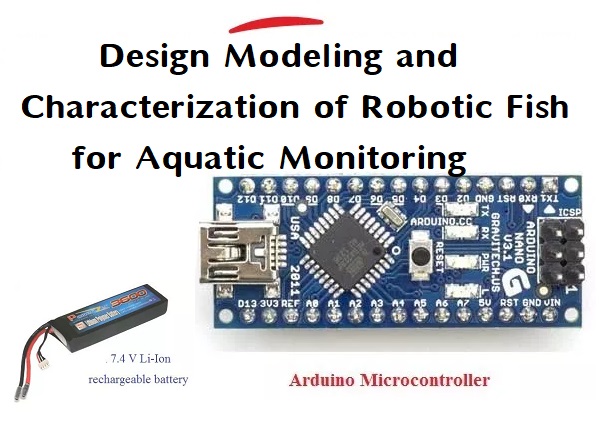Introducing a robot fish that is able to swim and recognize tank edges and obstacles. Find out how it can easily create it with common insulating material and a few servo motor controlled by Arduino. Arduino is a single-board microcontroller, intended to make the application of interactive objects or environments more accessible. The hardware consists of an open-source hardware board designed around an 8-bit Atmel AVR microcontroller, or a 32-bit Atmel ARM. Current models feature a USB interface, 6 analog input pins, as well as 14 digital I/O pins which allow the user to attach various extension boards.Using wireless camera is interface with fish robot use to surveillance purpose and monitoring purpose. In this wireless cam are connect to PC or TV.The size of the robotic fish is designed as 35cm length, 18cm height,10cm width and 1.500 grams weight respectively. In the prototype servo motor 3 could act as the motorized tail. For the fish body it used common polystyrene as the one used as insulating material for walls. Inexpensive, very robust and lightweight: it floats easily and is easily moldable. Great deal to make fish’s swimming more realistic, it need three joints between the trunk and the caudal fin. As actuators it have chosen of common modeling servos small, powerful enough and easily controlled by a microcontroller. The servos are ideal because with them it can manage the movement of a small shaft connecting all segments of the fish, varying at will the position, even a few degrees.
The fish body is divided into a central part and three parts, each of which moved by a servo. The caudal fin is made with plastic recycled from supermarket goods packages. The flexibility of the fin allows it to give more realism to movement. To obtain harmonic motion, each part is attached to the next by a servo: the body of the servo should be glued on a body segment while the servo arm (connected to the shaft) shall be glued on the next
A. Arduino microcontroller
The Arduino Nano is a small, complete, and breadboard-friendly board based on the ATmega328 (Arduino Nano 3.x) or ATmega168 (Arduino Nano 2.x). It has more or less the same functionality of the Arduino Duemilanove, but in a different package. It lacks only a DC power jack, and works with a Mini-B USB cable instead of a standard one. The Nano was designed and is being produced by Gravitech.
The ATmega168 has 16 KB of flash memory for storing code (of which 2 KB is used for the boot loader); the ATmega328has 32 KB, (also with 2 KB used for the boot loader). The ATmega168 has 1 KB of SRAM and 512 bytes of EEPROM (which can be read and written with the EEPROM library); the ATmega328 has 2 KB of SRAM and 1 KB of EEPROM.
The Arduino Nano can be programmed with the Arduino software (download). Select “Arduino Diecimila, Duemilanove, or Nano w/ ATmega168” or “Arduino Duemilanove or Nano w/ ATmega328” from the Tools > Board menu (according to the microcontroller on board).
The ATmega168 or ATmega328 on the Arduino Nano comes preburned with a boot loader that allows it to upload new code to it without the use of an external hardware programmer. It communicates using the original STK500 protocol.
B.Battery.
The important features of rechargeable battery High quality 7.4 V Li-Ion rechargeable battery pack, Made of 6 2200mAh cylindrical 18650 cells PCB and poly switch for full protection Light weight and higher energy density than any rechargeable battery, No memory effect and rechargeable, Longer storage life than NiMH battery, It can build 14.8V/6.6 ready battery module in parallel, Built-in IC chip will prevent battery pack from over charge and over discharge and prolongs battery life, Perfect for building 7.2V battery pack for bike lighting, RC toy (cars and airplanes), robots, cameras, DVD external battery.
C. Servo motor
The servo motor use PWM signal for controlling the DC motor; unlike normal PWM usually used in ordinary DC motor; this PWM signal is not use for controlling the rotation speed, instead it is use for controlling the motor direction or position. Most servo motor will work well on 50 Hz of PWM frequency; this mean the PWM signal should have a period of 20ms. The electronic circuit inside the servo motor will response to the PWM signal width; the 0.7ms to 1ms PWM width will make the servo motor to turn clockwise (CW), the 1.7ms to 2ms PWM width will make the servo motor to turn counterclockwise (CCW). For the standard servo the 1.5ms PWM width will turn the servo motor to its center.




